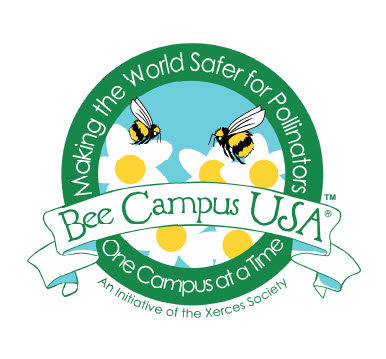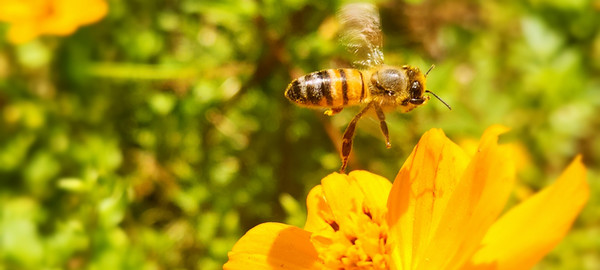Bee Campus
Program Overview & Information
About Bee Campus USA
Bee City USA and Bee Campus USA work to galvanize communities to sustain pollinators, in particular the more than 3,600 species of native bees in this country, by increasing the abundance of native plants, providing nest sites, and reducing the use of pesticides. Bee City USA and Bee Campus USA are initiatives of the Xerces Society for Invertebrate Conservation.
About Native Pollinators
Bees transfer pollen between flowers, enabling the incredible diversity of plants on our planet to fruit and reproduce. Pollinators are keystone species in essentially every ecosystem on earth, facilitating the reproduction of over 85 percent of all flowering plants and over two-thirds of agricultural crops.

In addition to the domestic honey bee (Apis mellifera), a species brought to North America from Europe, there are more than 3,600 species of bees native to the United States. These wild bees are generally quite different than the domesticated honey bee–most of them live solitary lives, with a single female doing all of the work to build a nest, collect pollen and nectar, and lay eggs.
Unlike the honey bee, which nests aboveground and can be managed in wooden hives, more than two out of three wild bees live underground in nests that can be hard to spot from the surface! Some dig down and lay their eggs several feet below ground, while others make nests near the soil surface or in hollowed out plant stems above ground. While bees are the most important pollinator, butterflies, moths, beetles, flies, wasps, and hummingbirds also contribute to pollination.
Research has shown significant declines in native pollinator population sizes and ranges globally with up to 40 percent of pollinator species on Earth at risk of extinction in the coming years as a result a variety of environmental stressors including habitat loss and degradation, exposure to pesticides, diseases and pathogens, and climate change.

Bee Campus USA Commitments
- Establish a standing Bee Campus USA committee.
- Create and enhance pollinator habitat on campus by increasing the abundance of native plants and providing nest sites.
- Reduce the use of pesticides.
- Offer courses or continuing education opportunities that incorporate pollinator conservation.
- Offer service-learning projects to enhance pollinator habitat.
- Display signage focused on pollinator conservation.
- Maintain an online presence for Bee Campus USA activities.
- Annually apply for renewal and report on the previous year’s activities.
Visit beecityusa.org for more information.

